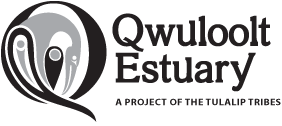Qwuloolt Estuary
Wildlife
In addition to providing extensive habitat for native fish species, the estuary provides habitat for an assortment of wildlife populations.
Birds
The mosaic of tidal marshes, forested wetlands, sloughs and mudflats within the estuary provide a wide range of foraging, nesting, and roosting habitats for over 350 species of migratory and resident birds. Some of the characteristic birds that can be found in the estuary include: Canada goose, Brandt’s cormorant, green-winged teal, tundra and trumpeter swan, great-blue heron, Bonaparte’s gull, ring-billed and mew gull, red-tailed hawk, kingfisher, bald eagle, osprey, and great-horned owl. The best time to see birds is early or late in the day and during the spring and summer when breeding birds return to mate and raise their young. Their bright plumage and songs help them attract mates and are a notable annual performance in the estuary. Bald eagles can be seen year round at the top of dead snags or spruce trees perching and looking for prey below.
Mammals
The Snohomish Estuary supports a diverse community of mammals. At the outlet to Puget Sound, you can see harbor seals and sea lions bobbing or barking in the waves. Further upriver, beaver, otter, and muskrat inhabit the sloughs and connecting stream channels. One can often see their slides along the muddy banks. Mink, raccoon, deer, coyote, porcupine, and small rodents live in the uplands habitats and can move between estuarine islands by swimming across the channels.


